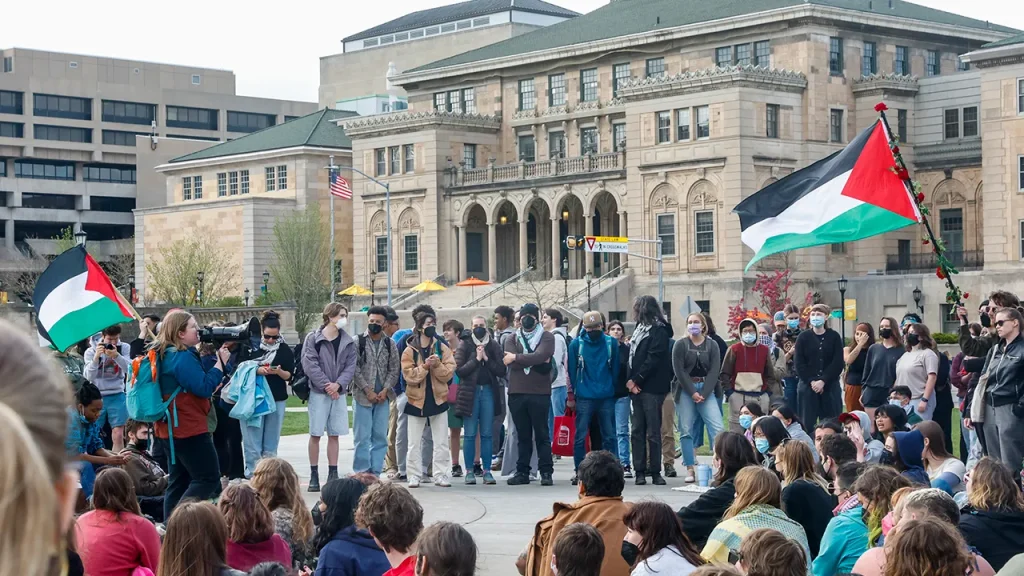Rising Tensions at University of Wisconsin-Madison: A Closer Look at Violent Imagery
In recent weeks, the University of Wisconsin-Madison campus has become a focal point of concern as disturbing violent imagery continues to appear both on and near the campus grounds. Students Aiden Wirth and Ben Rothove, both affiliated with the independent student newspaper The Madison Federalist, have documented these concerning displays, bringing them to public attention. The imagery, which has evolved over time but maintains consistent violent themes, includes slogans such as “The only good fascist is a dead fascist” and “Speak their language,” accompanied by graphic depictions of violence against figures portrayed as fascists, KKK members, or law enforcement. These incidents raise important questions about the boundaries of free expression, campus safety, and the increasingly polarized political climate on American university campuses.
The most recently documented images follow a disturbing pattern that appears to be escalating. One display featured the message “The only good fascist is a dead fascist” alongside an illustration of a fist punching a bloodied pig figure. Another showed a fist holding a smoking pistol to the head of a person in a Ku Klux Klan hood with blood spraying from the figure’s head, captioned with “Speak their language.” Similar imagery depicting violence against pigs (commonly used as derogatory symbols for police) and KKK figures appeared repeatedly with the same messaging. The consistency in style and messaging suggests these are not isolated incidents but rather part of a coordinated effort to spread these violent sentiments around the campus community, creating an atmosphere of tension and unease for many students regardless of their political affiliations.
Prior to these recent discoveries, campus police had already confirmed they were investigating similar imagery showing violence against Immigration and Customs Enforcement (ICE) agents. One such image depicted an ICE agent being shot in the head with the now-familiar phrase “The only good fascist is a dead fascist.” Another showed similar violence with the caption “Speak their language” and “You can’t vote away fascism.” These earlier incidents establish a timeline of escalating violent imagery that has now expanded beyond targeting specific law enforcement agencies to broader symbolism of political violence. The university police department has acknowledged these incidents and confirmed ongoing investigations, though there have been no public announcements regarding identified perpetrators or potential consequences as of this reporting.
The university’s response has remained consistent throughout these incidents, with spokesperson John Lucas stating that “UW-Madison condemns violence of all kinds.” The administration has encouraged students who feel affected by these displays to reach out to the Office of Student Assistance and Support. Additionally, they’ve asked campus community members to report any discovered stickers or posters to campus police for investigation and removal. However, some students and observers question whether this response is sufficient given the increasingly graphic nature of the displays and their potential impact on campus climate. The tension between free speech protections and maintaining a safe, respectful campus environment presents challenges for university administrators navigating these incidents, especially in today’s highly charged political atmosphere.
These incidents at UW-Madison don’t exist in isolation but rather reflect broader tensions playing out on university campuses nationwide. The imagery’s focus on “fascism” and violent resistance mirrors rhetoric that has become more common in certain activist circles, particularly in response to perceptions of rising authoritarianism or institutional violence. However, the explicit advocacy for violence—even symbolic violence—crosses important lines of civil discourse that universities traditionally strive to maintain. The situation raises difficult questions about where to draw boundaries between protected political expression, even when provocative, and advocacy for violence that may create a threatening environment for students, faculty, and staff. These incidents force campus communities to grapple with competing values of free expression, safety, and fostering environments where productive dialogue can occur across political differences.
As this situation continues to develop, the university faces mounting pressure to address not just the immediate issue of removing offensive materials but the underlying campus climate that may be contributing to or affected by these displays. The documentation of these incidents by student journalists highlights the important role that independent campus media plays in bringing attention to issues that might otherwise remain unaddressed. For students like Wirth and Rothove who have documented these displays, the experience likely underscores the challenges of navigating increasingly polarized campus environments where political expression seems to be taking increasingly extreme forms. Moving forward, the UW-Madison community, like many other campuses across America, will need to find ways to uphold principles of free expression while also ensuring that all community members feel safe and respected—a delicate balance that has become increasingly difficult to maintain in our current political moment.


